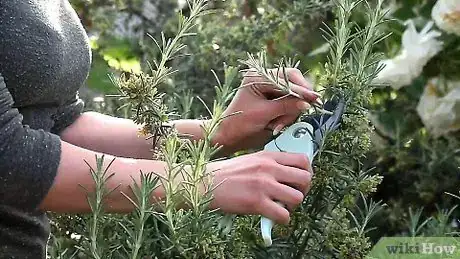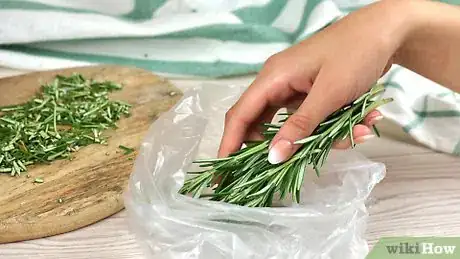This article was co-authored by wikiHow Staff. Our trained team of editors and researchers validate articles for accuracy and comprehensiveness. wikiHow's Content Management Team carefully monitors the work from our editorial staff to ensure that each article is backed by trusted research and meets our high quality standards.
There are 7 references cited in this article, which can be found at the bottom of the page.
The wikiHow Video Team also followed the article's instructions and verified that they work.
This article has been viewed 55,283 times.
Learn more...
Fresh rosemary is a great way to add some herby flavor and freshness to a wide variety of dishes. If you’re growing your rosemary, you can cut fresh rosemary right off the plant to use or store. Once you've harvested or purchased fresh sprigs of rosemary, you can use either a chef’s knife or kitchen scissors to chop or mince the rosemary leaves into the desired consistency. Soon enough, you’ll be sprinkling fresh, fragrant rosemary into all kinds of recipes!
Steps
Trimming Rosemary From a Plant
-
1Harvest rosemary in the spring or summer if you want it to grow back. Wait until the growing season, which is during spring and summer after the last winter frost, to harvest fresh rosemary. This way, it will grow back and replenish itself.[1]
- You can trim sprigs of rosemary off your plants whenever you want to use some, but just know that if you harvest rosemary during the fall or winter it won’t grow back until the following spring.
-
2Snip off rosemary stems at the base using sharp garden shears or scissors. Get as close to the place where the stem comes off the main stock of the rosemary plant. Ensure your garden shears or scissors are very sharp so you can easily cut through the woody stalks of the rosemary sprigs.[2]
- This method applies to both rosemary plants in a garden and potted rosemary plants.
Advertisement -
3Cut up to 1/3 of the stems off a rosemary plant at one time. Try to take stems from various parts of the rosemary plant rather than all from the same spot and don’t cut off more than 1/3 of the plant’s growth at any given time. This will allow the plant to grow back healthy new stems and replenish itself.[3]
- Make sure you let the plant replace the growth you cut away before you harvest from it again.
-
4Take smaller, younger stems from rosemary plants for the freshest taste. Trim off the smallest, newest stems when you harvest fresh rosemary if you want the most rosemary flavor from the leaves. The young leaves are also the most fragrant.[4]
- You can either use fresh rosemary right away, store it in airtight containers for up to 2 weeks, or dry it and store it indefinitely.
-
5Freeze or dry unused fresh rosemary to preserve it. Put fresh rosemary sprigs in a freezer bag and store them in the freezer for up to 6 months if you want to keep them fresh. Tie rosemary sprigs together in bundles and hang them up in an airy, dry place inside your home if you want dried rosemary.[5]
- You can also dry rosemary out in the oven by spreading the sprigs out on a baking sheet and putting them in the oven at the lowest possible temperature for 2-4 hours. Alternatively, you can use a food dehydrator if you have one.
Chopping and Mincing Rosemary
-
1Rinse fresh rosemary under cool running water. Place sprigs of freshly harvested or purchased rosemary into a strainer or colander. Hold the rosemary under the faucet of your kitchen sink and turn the cold water on. Move the strainer or colander around under the stream of water and move the sprigs around with one of your hands until you thoroughly rinse off all the rosemary.[6]
- Always wash your rosemary and strip the leaves off of the stems before you cut rosemary to clean off any dirt or pesticides and separate the leaves from the tough woody stems, which are not usable.
-
2Use paper towels or a salad spinner to dry the rosemary. Lay the sprigs of rosemary out on a doubled-up paper towel on a kitchen counter and pat them dry with another paper towel or two. Place the sprigs in a salad spinner and spin the handle to dry off the rosemary as an alternative to using paper towels.[7]
- It’s easier to cut rosemary when it’s dry. If the leaves are wet, they can stick together, making it more difficult to cut them uniformly.
-
3Run your fingers along a stem of rosemary to strip the leaves off. Hold a sprig of rosemary in one hand by the end of its stem. Place the index finger and thumb of your other hand just below where you are holding the stem, then run your fingers firmly down the length of the stem to strip the leaves off.[8]
- You can do this over a cutting board, a measuring cup, a bowl, or another container of some kind.
-
4Place fresh rosemary leaves onto a cutting board. Set a cutting board on your kitchen counter or another flat work surface. Put leaves stripped from a fresh sprig of rosemary into the center of the cutting board.[9]
- Try to cut only as much rosemary as you plan to use. Fresh rosemary will last longer if you keep it intact.
-
5Arrange the leaves into a neat pile with all the tips going in the same direction. Bunch the leaves together as closely as you can using both hands to scrape them into a neat pile. Inspect the pile carefully and reposition any leaves that are facing in different directions.[10]
- This will make it easier to cut the rosemary into equally-sized pieces.
-
6Use a chef’s knife to slice one way across the leaves to chop the rosemary. Start at one end of the pile of rosemary leaves and slice across them horizontally. Work your way down the entire length of the pile, slicing in the same direction, until you have a pile of uniformly-chopped rosemary.[11]
- If you do end up chopping too much rosemary, you can store the leftover pieces in a sealable plastic bag or a small jar for up to about 2 weeks.
-
7Slice the leaves again, going the other way across the pile, to mince the rosemary. Turn your cutting board or your knife 90 degrees so you can cut across the leaves in the other direction. Start at one end of the pile and chop your way along with the pile until the rosemary is minced into small pieces.[12]
- You can repeat this process multiple times, alternating which way you slice across the pile of leaves if you want very finely-minced pieces of rosemary.
-
8Snip the rosemary leaves up using sharp kitchen scissors as an alternative. Put the fresh rosemary leaves into a measuring cup or bowl. Use the tips of a pair of kitchen scissors to snip up the rosemary leaves using short, fast strokes and going back and forth across the pile of leaves. Keep snipping the rosemary until you get the consistency you want.[13]
- If you don’t have kitchen scissors, you can use a pair of sharp household scissors. If you do so, make sure to wash them with soap and water first.
Tip: You can purchase a pair of special herb scissors to make this task even easier. Herb scissors have multiple blades and a spring mechanism that makes it very quick and easy to cut rosemary or any other type of fresh herb.
Things You’ll Need
Trimming Rosemary From a Plant
- Sharp garden shears or scissors
Chopping and Mincing Rosemary
- Fresh rosemary sprigs
- Colander or strainer
- Cutting board
- Chef’s knife (Sharp)
- Measuring cup or bowl (optional)
- Kitchen scissors (optional)
References
- ↑ https://www.thekitchn.com/everything-you-need-to-know-about-growing-rosemary-221276
- ↑ https://www.youtube.com/watch?v=T_D6GTmKgT8&t=25
- ↑ https://www.almanac.com/plant/rosemary
- ↑ https://www.almanac.com/plant/rosemary
- ↑ https://www.thekitchn.com/4-ways-to-preserve-fresh-rosemary-221277
- ↑ https://www.bhg.com/recipes/how-to/cooking-basics/cooking-fresh-herbs/
- ↑ https://www.bhg.com/recipes/how-to/cooking-basics/cooking-fresh-herbs/
- ↑ https://www.realsimple.com/food-recipes/shopping-storing/herbs-spices/chop-rosemary-thyme
- ↑ https://www.realsimple.com/food-recipes/shopping-storing/herbs-spices/chop-rosemary-thyme
About This Article
To cut fresh rosemary from your garden, snip off the sprigs of rosemary at the base where they come off of the main stock. Only cut up to a third of the sprigs off of the rosemary at a time so the plant continues to grow. Rinse the sprigs off with cool water to clean them, then dry them with paper towels. Run your fingers along the stems to pull off the leaves. Then, arrange the leaves in a pile and use a chef's knife to cut across the pile horizontally. Finally, cut across the pile vertically to mince the rosemary. To learn how to cut fresh rosemary using scissors, scroll down!




















































